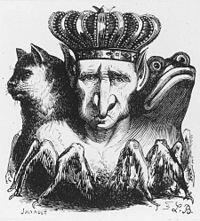Bael is a potent demon with unique attributes that practitioners of occultism and witchcraft can harness for various spellcasting purposes. His abilities to confer invisibility, power, and knowledge can be invaluable in achieving personal goals.
While distinct from Beelzebub, both demons offer unique opportunities for those who work with them in their spiritual practices.
Demon Bael: Overview

Identity and Attributes
- Bael is a significant figure in demonology, often listed as the first king in the hierarchy of Hell according to the Lesser Key of Solomon (also known as the Goetia). He is depicted as a powerful demon who can take on different forms, including that of a cat, toad, or human, and sometimes described as having multiple heads.
- Powers: Bael is known for his abilities related to invisibility, commanding legions of spirits, and providing knowledge and wisdom, particularly in matters of power and influence.
Utilizing Bael in Spellcasting
1. Invisibility and Disguise Spells
- Use in Spellcasting: Practitioners can invoke Bael to assist in spells aimed at becoming less noticeable or for protection from negative attention.
- Method: Prepare a ritual with a focus on invisibility. Use dark-colored candles and specific herbs like black pepper or sage. During the ritual, invoke Bael to cloak you in his powers.
2. Power and Influence
- Use in Spellcasting: Bael can aid those seeking to enhance their personal power or gain influence in social or professional situations.
- Method: Create an altar with symbols of power (like a lion or a crown) and light a candle. State your intention clearly and ask Bael to guide you in asserting your influence effectively.
3. Knowledge and Wisdom
- Use in Spellcasting: For those seeking guidance or insight into complex situations, Bael can provide clarity and wisdom.
- Method: When engaging in divination practices (like tarot or scrying), invite Bael to assist in revealing hidden truths. Light a candle and ask for his insight during your reading.
Benefits of Working with Bael
-
Enhanced Discretion: Working with Bael can help practitioners navigate situations where they need to remain unnoticed or hidden, providing a sense of safety.
-
Increased Personal Power: By invoking Bael, practitioners may feel a boost in their self-confidence and assertiveness, allowing them to take charge of their lives more effectively.
-
Access to Knowledge: Bael’s association with wisdom can help practitioners gain insights and understanding, particularly in strategic or influential matters.
-
Commanding Presence: Those seeking to assert dominance in a situation may find Bael’s energy helpful, especially in competitive environments.
Is Bael the Same as Beelzebub?
While Bael and Beelzebub are both considered demons within various occult traditions, they are not the same entity:
-
Bael: Often described as a king with specific abilities related to invisibility and influence. He is primarily noted in the Goetia and is associated with commanding spirits.
-
Beelzebub: Sometimes referred to as “Lord of the Flies,” Beelzebub is often depicted as a high-ranking demon or even equated with the devil in some traditions. He has associations with gluttony and chaos.
Other Names Known By:
- Bael, Baël (French), Baell.
Common correspondences

- #1 Demon of the Goetia
- Zodiac Position: 0-4 Degrees of Aries
- March 21st-25th *(March 21-30)
- Tarot Card: 2 of Rods (From Azazel)
- Candle color: Black
- Plant: Fern
- Planet: Sun
- Metal: Iron *(Gold)
- Element of Fire
- Rank: King
- Bael is a Day Demon
- Rules over 66 legions of spirits.
ENN:
Bael – Ayer Secore On Ca Ba’al
HISTORY OF BAAL
Back in the time before Abrahamic religions, when there were many gods, people were “Pagan”.
In Canaanite, EL was a key God and his son was/is Ba’al.
Baal is a Christian demon. Baal was the most important god of the ancient Canaanites.
Baal is actually a general word meaning “lord.” In religious contexts, the specific lord in question is usually the Canaanite god of rain, dew, and fertile fields.. This god is said to ride on the clouds. He is also called “Prince Baal.” In Semitic languages, the phrase is Baal zebul.
CLASSIC TEXTS
“Baal, Bale – (Hebrew) Devil. Means “the lord.” The Canaanites worshipped Baal and held rituals at which children were burned for sacrifice. According to Wineries, this demon is the first monarch of hell and appears as a three headed beast. Bale is cited in the Grand Grimier as commanding general of infernal armies.”
– Source: The Complete Book of Demonolatry S. Connolly
“The First Principal Spirit is a King ruling in the East, called Bael. He maketh thee to go Invisible. He ruleth over 66 Legions of Infernal Spirits. He appeareth in divers shapes, sometimes like a Cat, sometimes like a Toad, and sometimes like a Man, and sometimes all these forms at once. He speaketh hoarsely. This is his character which is used to be worn as a Lamen before him who calleth him forth, or else he will not do thee homage.”
– Source: Goetia: The Lesser Key of Solomon: The Initiated Interpretation of Ceremonial Magic http://amzn.to/2dp0MTL
SOURCE:
Wikipedia (2005). Baal. Retrieved Nov 18, 2005
